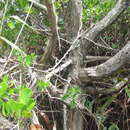pms
nòm ant ël fil


Lumnitzera racemosa, commonly known as the white-flowered black mangrove,[4] is a species of mangrove in the family Combretaceae.[5] It is found on the eastern coast of Africa and other places in the western Indo-Pacific region.[6] It has one accepted variety from the noniminate species, Lumnitzera racemosa var. lutea (Gaudich.) Exell.[7][8]
Lumnitzera racemosa is a small to medium-sized evergreen tree, growing to a maximum height of 37 m (121 ft). It develops pneumatophores and often has stilt roots. The leaves are arranged spirally at the tips of the shoots; they are simple and obovate, with slightly toothed margins. The inflorescences grow in short spikes in the axils of the leaves or at the tips of the shoots. The flowers are small and white, and are followed by woody, flattened fruits containing a single seed.[9]
This species is native from KwaZulu-Natal to southeast Kenya in the western Indian Ocean, tropical & subtropical Asia to the western Pacific.[3] Its range includes KwaZulu-Natal, Mozambique, Tanzania, Kenya, Madagascar, Aldabra, Seychelles, Chagos Archipelago, Maldives, India, Sri Lanka, Andaman Islands, Nicobar Islands, Bangladesh, Myanmar, Thailand, Cambodia, Vietnam, southeast China, Hainan, Taiwan, Nansei-shoto, Korea, South China Sea, Philippines, Peninsular Malaysia, Jawa, Lesser Sunda Islands, New Guinea, and New Caledonia. In Mozambique it is one of only ten mangrove species.[6] It grows in the higher part of the intertidal zone and is found both on beaches and lining the banks of creeks. It is a fast-growing, pioneering species.[1]
The timber of Lumnitzera racemosa is strong and durable and has many uses, including bridge construction.[10] The wood is highly favoured for charcoal making in Cambodia. The bark is harvested for the tannins it contains.[11]
Mangroves in general are under threat from coastal development, and this species, which grows on the landward edge of the mangrove area, may be more threatened by rising sea levels than are other species because it may be unable to move further inland. There may be a decline in populations of this species due to habitat loss or harvesting, but it is a common species of mangrove with a very wide range, and is not declining at a sufficient rate to be included in any threatened category, so it is listed by the International Union for Conservation of Nature as being of "least concern".[1]
The plant is known by a variety of common names. These include krâ:nhob sâ: (sâ:=white< Khmer)
Lumnitzera racemosa, commonly known as the white-flowered black mangrove, is a species of mangrove in the family Combretaceae. It is found on the eastern coast of Africa and other places in the western Indo-Pacific region. It has one accepted variety from the noniminate species, Lumnitzera racemosa var. lutea (Gaudich.) Exell.
Lumnitzera racemosa (Willd., 1803) è una mangrovia appartenente alla famiglia delle Combretaceae, diffusa nelle foreste costiere dell'oceano Indiano e del Pacifico centro-occidentale[2].
Oltre alla specie in sé, di L. racemosa è accettata una sola varietà[2], endemica del Vietnam[3]:
Lumnitzera racemosa (Willd., 1803) è una mangrovia appartenente alla famiglia delle Combretaceae, diffusa nelle foreste costiere dell'oceano Indiano e del Pacifico centro-occidentale.
Cọc vàng[1] (danh pháp khoa học: Lumnitzera racemosa) là một loài thực vật có hoa trong họ Trâm bầu. Loài này được Willd. miêu tả khoa học đầu tiên năm 1803.[2]
Cọc vàng (danh pháp khoa học: Lumnitzera racemosa) là một loài thực vật có hoa trong họ Trâm bầu. Loài này được Willd. miêu tả khoa học đầu tiên năm 1803.
榄李(学名:Lumnitzera racemosa)是使君子科榄李属的植物。分布于马来西亚、波利尼西亚、东非、大洋洲、亚洲、台湾岛、印度、马达加斯加以及中国大陆的广东、广西等地,多生长在海岸以及红树林沼泽,目前尚未由人工引种栽培。
滩疤树(海南)
|access-date=中的日期值 (帮助) 榄李(学名:Lumnitzera racemosa)是使君子科榄李属的植物。分布于马来西亚、波利尼西亚、东非、大洋洲、亚洲、台湾岛、印度、马达加斯加以及中国大陆的广东、广西等地,多生长在海岸以及红树林沼泽,目前尚未由人工引种栽培。

ヒルギモドキ(蛭木擬、学名:Lumnitzera racemosa)はシクンシ科ヒルギモドキ属の常緑木本。潮間帯に生育するマングローブ樹種のひとつ。なお、和名の似ているヒルギダマシはクマツヅラ科(あるいはキツネノマゴ科)の植物である。
成木で高さ10m程度となる常緑小高木だが、北限となる沖縄では高さ4m~5m程度までの個体が多い。他のマングローブ植物より比較的陸化した砂質の場所を好む。幹は直立。また、呼吸根は目立たず、株を中心にした地上部から匍匐根として周囲に伸び、その先端で分枝して土壌に入り込む。葉は比較的多肉で、長さ5cm程度で枝の先に多く、互生する。形状は卵形から長楕円形。先端に凹みがあることが大きな特徴である。花期は3-7月。花は総状花序で腋生。5mm程度で白い5枚の花弁を持つ[1][2]。萼(萼筒)は緑色で、先端は裂けるが短い。果実は長さ1cm程度の長楕円形で、緑色で、頂端に萼歯が残る
フランシスコ・マヌエル・ブランコによるヒルギモドキの絵
東アフリカ熱帯域から南アジア、オーストラリアの熱帯および亜熱帯の海岸に広く分布し、日本国内では、南西諸島(沖縄本島・久米島?・宮古島・石垣島・小浜島・西表島・与那国島)に分布する。分布の北限は沖縄本島である。
沖縄諸島全体の汽水域にマングローブとして生える。特に沖縄本島の株は本種の世界的な北限でもある。久米島での生育状況は不明で、石垣島と西表島では工事等の影響で自生地が消失している。このため世界的には広い分布域を持つ本種であるが、日本では個体数が少なく、なおかつ生息地の埋め立てや土砂の堆積、乾燥化した部分への他の植物の侵入・競争により個体数は減少を続けている。またはっきりとした帯状分布を示さずに、マングローブの林縁部などに小群や単一の株として生育する[3]。絶滅危惧IA類 (CR)(環境省レッドリスト)に指定されている。
中近東などでは、ラクダ等の飼料として利用されるほか、木炭原料や、パルプとして製紙原料とされる。
ヒルギモドキ(蛭木擬、学名:Lumnitzera racemosa)はシクンシ科ヒルギモドキ属の常緑木本。潮間帯に生育するマングローブ樹種のひとつ。なお、和名の似ているヒルギダマシはクマツヅラ科(あるいはキツネノマゴ科)の植物である。